Flashing Linux disk images from an initramfs
Recently I did a few installations of a preseeded iso (for centos, "kickstarted"), but this takes longer than necessary and is just plain wrong; there's no need to re-do the same work hundreds of times at install time when all servers will end up being the exact same!
This was kicked off on an afternoon when I was flashing my Raspberry Pi, if these embedded boards can flash an image that's good enough and boot into it, even when there are some slight discrepancies in the hardware (network is using ethernet or wifi, sd cards are of different sizes, memory available changes across models, etc), why can't my servers do it? Why is no one doing this? Apart from the fact that everyone is using docker/kubernetes or something similar, which behaves similarly to what I want.
Contents
- Figuring out what I need
- Generating an initial filesystem
- Flashing a hard drive from initramfs
- Booting into the new system without re-booting
- Results
Figuring out what I need
What I want is simple: generate a "golden" disk image and "flash" it (write it to disk) without needing physical access
I started my investigation thinking of some magical API that'd be present on HP's iLO and Dell's iDRAC that would let me write bytes to disk (somehow?) but apparently this is not the case.
Next I thought about network booting something, but I couldn't find anything online that had this capability, so.. how hard is it to PXE boot a bit of code that downloads an image from the network and writes it to disk?
For PXE booting you need only two things: the kernel and the initial filesystem (initramfs).
I will not worry about the kernel at this point as I'll just copy whatever I
have now in /boot/vmlinuz-$(uname -r).
Generating an initial filesystem
Generating the initial filesystem (initramfs) is not hard, if you are aware that:
- it must be in
cpioformat (apparently some format and utility for tape backups standardized in '88) - the kernel will execute whatever it finds in
/init
First, we need to write an executable that can be kicked off by the kernel. Remember that unless we provide them, things like dns, libc, etc are not available. Compiling binaries in a static form is the best route to take.
For this example I picked a basic go example:
initramfs/init.go:
package main
import "fmt"
import "time"
func main() {
fmt.Println("Hi. I will sleep forever now")
time.Sleep(2 * time.Hour)
}
To build the initramfs, we have to list all the files from the point of view of
/ so that means we have to cd into the directory containing all of our
files, and perform the magic incantation that cpio requires:
( cd initramfs/; go build init.go; find . | cpio -H newc -o > ../initramfs.raw )
The initramfs looks like this:
initramfs
├── init
└── init.go
Although the .go file is not required, I'll leave it there as that is my
current repo.
With this initramfs cpio file, we can start a virtual machine by running
kvm -kernel /boot/vmlinuz-$(uname -r) -initrd initramfs.raw
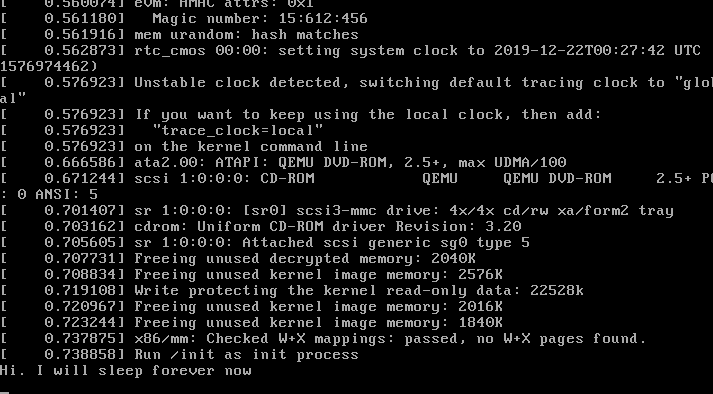
It works!
You can find the example here.
Generating a slightly more useful initial filesystem
Now that we know how the mechanism works we can get a slightly more useful filesystem and for this we need busybox, as the most-appropiate way of interacting with a bare-bones file system is with unix tools instead of custom applications.
Busybox is a set of stripped-down utilities that were designed for exactly this kind of use-case: a stand-alone minimal interactive system.
First, you need to clone busybox from their github repository and statically build it with the following script
make defconfig
make clean && make LDFLAGS=-static -j$(nproc)
If this is successful, it will generate a statically compiled busybox binary, that contains a lot of useful commands
$ file busybox/busybox
busybox/busybox: ELF 64-bit LSB executable, x86-64, version 1 (GNU/Linux), statically linked, BuildID[sha1]=2a2d8183ddf2a07a507554c1e5e3f4aec30e040b, for GNU/Linux 3.2.0, stripped
$ ldd busybox/busybox
not a dynamic executable
$ ./busybox/busybox
Currently defined functions:
[, [[, acpid, add-shell, addgroup, adduser, adjtimex, arch, arp, arping, ash, awk, base64, basename, bc, beep, blkdiscard, blkid, blockdev, bootchartd, brctl, bunzip2, bzcat, bzip2, cal, cat, chat, chattr, chgrp, chmod, chown, chpasswd, chpst,
chroot, chrt, chvt, cksum, clear, cmp, comm, conspy, cp, cpio, crond, crontab, cryptpw, cttyhack, cut, date, dc, dd, deallocvt, delgroup, deluser, depmod, devmem, df, dhcprelay, diff, dirname, dmesg, dnsd, dnsdomainname, dos2unix, dpkg, dpkg-deb,
du, dumpkmap, dumpleases, echo, ed, egrep, eject, env, envdir, envuidgid, ether-wake, expand, expr, factor, fakeidentd, fallocate, false, fatattr, fbset, fbsplash, fdflush, fdformat, fdisk, fgconsole, fgrep, find, findfs, flock, fold, free,
freeramdisk, fsck, fsck.minix, fsfreeze, fstrim, fsync, ftpd, ftpget, ftpput, fuser, getopt, getty, grep, groups, gunzip, gzip, halt, hd, hdparm, head, hexdump, hexedit, hostid, hostname, httpd, hush, hwclock, i2cdetect, i2cdump, i2cget, i2cset,
i2ctransfer, id, ifconfig, ifdown, ifenslave, ifplugd, ifup, inetd, init, insmod, install, ionice, iostat, ip, ipaddr, ipcalc, ipcrm, ipcs, iplink, ipneigh, iproute, iprule, iptunnel, kbd_mode, kill, killall, killall5, klogd, last, less, link,
linux32, linux64, linuxrc, ln, loadfont, loadkmap, logger, login, logname, logread, losetup, lpd, lpq, lpr, ls, lsattr, lsmod, lsof, lspci, lsscsi, lsusb, lzcat, lzma, lzop, makedevs, makemime, man, md5sum, mdev, mesg, microcom, mkdir, mkdosfs,
mke2fs, mkfifo, mkfs.ext2, mkfs.minix, mkfs.vfat, mknod, mkpasswd, mkswap, mktemp, modinfo, modprobe, more, mount, mountpoint, mpstat, mt, mv, nameif, nanddump, nandwrite, nbd-client, nc, netstat, nice, nl, nmeter, nohup, nologin, nproc, nsenter,
nslookup, ntpd, nuke, od, openvt, partprobe, passwd, paste, patch, pgrep, pidof, ping, ping6, pipe_progress, pivot_root, pkill, pmap, popmaildir, poweroff, powertop, printenv, printf, ps, pscan, pstree, pwd, pwdx, raidautorun, rdate, rdev,
readahead, readlink, readprofile, realpath, reboot, reformime, remove-shell, renice, reset, resize, resume, rev, rm, rmdir, rmmod, route, rpm, rpm2cpio, rtcwake, run-init, run-parts, runlevel, runsv, runsvdir, rx, script, scriptreplay, sed,
sendmail, seq, setarch, setconsole, setfattr, setfont, setkeycodes, setlogcons, setpriv, setserial, setsid, setuidgid, sh, sha1sum, sha256sum, sha3sum, sha512sum, showkey, shred, shuf, slattach, sleep, smemcap, softlimit, sort, split, ssl_client,
start-stop-daemon, stat, strings, stty, su, sulogin, sum, sv, svc, svlogd, svok, swapoff, swapon, switch_root, sync, sysctl, syslogd, tac, tail, tar, taskset, tc, tcpsvd, tee, telnet, telnetd, test, tftp, tftpd, time, timeout, top, touch, tr,
traceroute, traceroute6, true, truncate, ts, tty, ttysize, tunctl, ubiattach, ubidetach, ubimkvol, ubirename, ubirmvol, ubirsvol, ubiupdatevol, udhcpc, udhcpc6, udhcpd, udpsvd, uevent, umount, uname, unexpand, uniq, unix2dos, unlink, unlzma,
unshare, unxz, unzip, uptime, users, usleep, uudecode, uuencode, vconfig, vi, vlock, volname, w, wall, watch, watchdog, wc, wget, which, who, whoami, whois, xargs, xxd, xz, xzcat, yes, zcat, zcip
The way to execute any of these commands is to give it as an argument to
busybox, so to execute ls you have to execute ./busybox ls. This is useful,
yet annoying as we don't want to either type all of that, or include it in our
scripts. Helpfully, busybox also includes an installation parameter, which will
make it symlink all of the commands that it contains to /bin.
With plenty of shell commands at our disposition, we can replace our golang init with a shell script:
#!/busybox sh
echo hello from sh!
/busybox mkdir /bin
/busybox --install -s /bin
pwd
ls
date
which vi
exec sh
and we have all of this with only 2 files in our initramfs
$ tree initramfs
initramfs
├── busybox
└── init
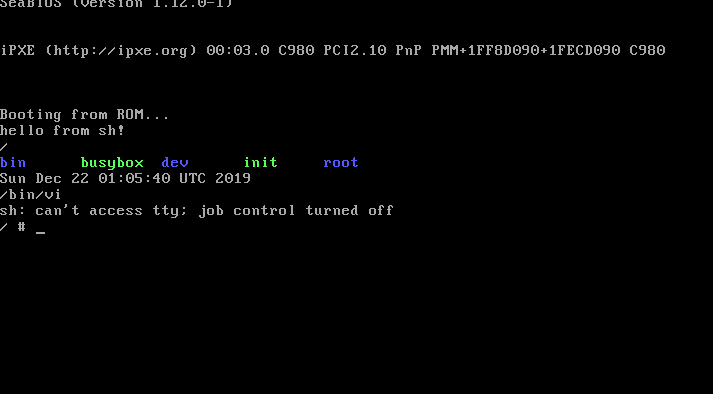
It works as well!.
You can find the example here.
Generating the real initramfs
For the actual initramfs we want a few things:
- Network connectivity
- A program that can download files over network
- To be able to mount the freshly-flashed filesystem
Keep in mind that, in general, the support that we'll have in our initramfs for devices will be quite poor as we are lacking all the kernel modules that usually accompany the kernel (they live in /lib, we don't even have /lib yet!). There are two ways to add driver support in an initramfs:
- Re-Compile the kernel with builtin drivers for what you need
- Provide the kernel object files (.ko) and all the required dependencies in paths expected by the kernel.
I opted with copying the .ko files around for now.
For network connectivity, it starts getting a bit specific with regards of
what type of NIC you'll have installed, but for now we'll continue with the
e1000, the generic driver that you can use with qemu.
Find and copy the required kernel module:
$ find /lib -path "*$(uname -r)*" -name e1000.ko
/lib/modules/5.0.0-27-generic/kernel/drivers/net/ethernet/intel/e1000/e1000.ko
Once that file is present (in the same path!) in your initramfs, you should be able to run (adjusted for your network setup..)
modprobe e1000
ifconfig eth0 192.168.2.33 netmask 255.255.255.0 up
route add default gw 192.168.2.1
and be pingable! without even a disk!
While having a network is a big step forward, we still need some kind of software that will allow us to download files. I did not think too much about this and went with cURL, but maybe wget or some other tool would've been easier.
As with busybox, clone curl and build it to get a static binary:
./buildconf
./configure --disable-shared
make curl_LDFLAGS=-all-static
which will give you a static curl binary.
Ok, we have networking support, we have curl, now we have to manually set up the network device:
mkdir /etc /proc /sys
mount -t proc proc /proc
mount -t sysfs sysfs /sys
modprobe e1000
ifconfig eth0 192.168.2.33 netmask 255.255.255.0 up
route add default gw 192.168.2.1
echo "nameserver 192.168.2.1" > /etc/resolv.conf
and adjust our kvm invocation to also pass in a network device:
kvm -kernel /boot/vmlinuz-$(uname -r) -initrd initramfs.igz -m 512 -cpu host -append quiet -device e1000,netdev=net0,mac=DE:AD:BE:EF:88:39 -netdev tap,id=net0
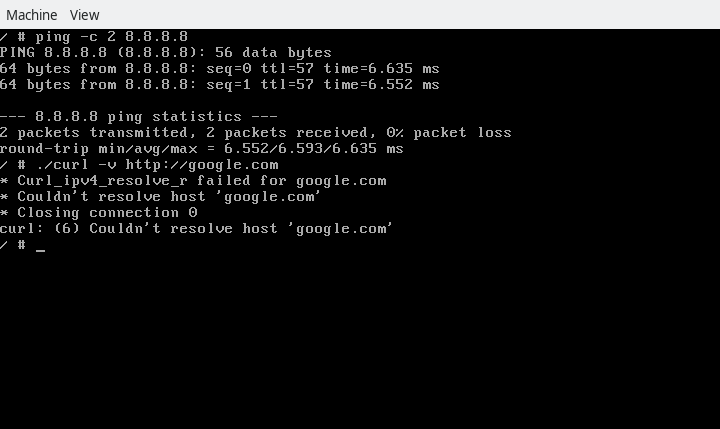
Why is DNS not working? Because it's provided by shared objects and we don't have them in our initrd!
If we had been paying attention to the build, it did warn us about it:
curl_addrinfo.c:(.text+0x203): warning: Using 'getaddrinfo' in statically linked applications requires at runtime the shared libraries from the glibc version used for linking
A great way to avoid this, is to build a DNS resolver right into curl,
conveniently, curl supports ares so that means that adding --enable-ares
to the configure call solves our problem:
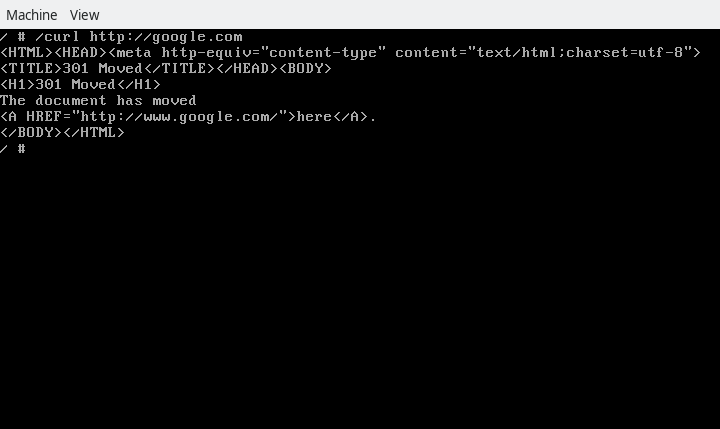
and again, we can make this happen with very few files:
$ find initramfs/ -type f
initramfs/curl
initramfs/lib/modules/5.0.0-27-generic/kernel/drivers/net/ethernet/intel/e1000/e1000.ko
initramfs/init
initramfs/busybox
You can find the example here.
Flashing a hard drive from initramfs
We are at the last step! We can now download a file from the network so let's
write it to disk, we only have to add a few things to the last init:
/curl http://david-pc.labs:8000/newfs.img --output newfs.img
echo 'Downloaded.. flashing'
dd if=newfs.img of=/dev/sda bs=1M conv=notrunc
echo 'Done!'
exec sh
but now, we need to pass a disk to kvm so it has a place to write to, we can do
so by appending -drive file=test-disk.img,format=raw to the kvm invocation.
Creating the test-disk.img file is easy: just write a lot of zeroes to it: dd
if=/dev/zero of=test-disk.img bs=1M count=1000
Keep in mind that this is an initial ram filesystem, your virtual machine must have enought ram assigned to it to keep the entire filesystem image in memory.
Now.. the image is complaining that /dev/sda does not exist, and indeed, poking
at /dev/ shows that no devices were automatically created. Of course not!
There's no udev in this system.. this mechanism can get triggered by running
mdev (from busybox)
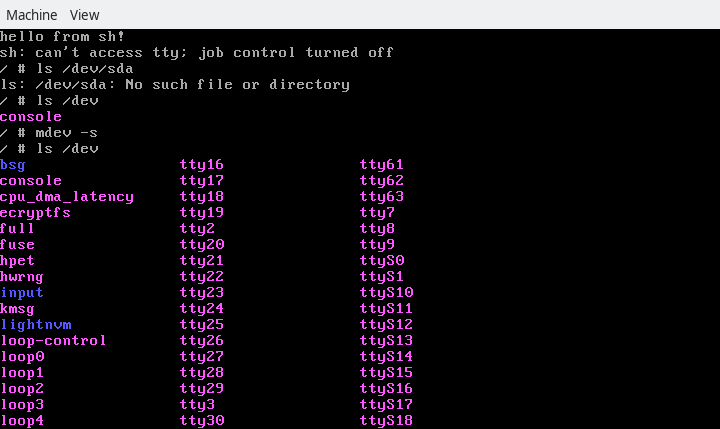 With the disk block device ready, we can run the disk flashing from initramfs
With the disk block device ready, we can run the disk flashing from initramfs
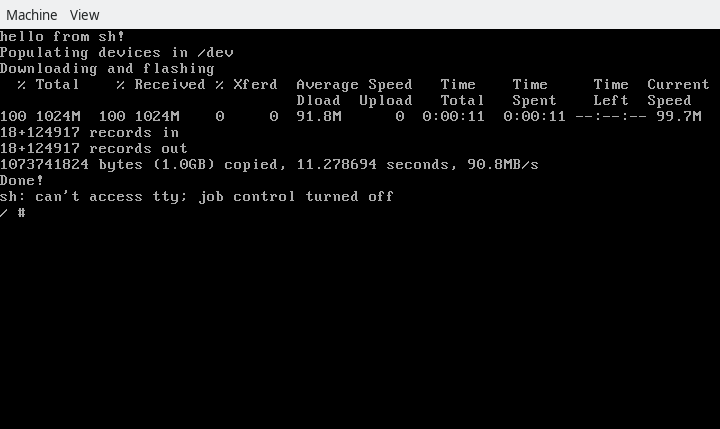
Disk is flashed. We can't just reboot -- we'll boot straight back into the
initramfs, so we have to tweak our kvm invocation to not use the initrd for
booting:
kvm -m 2048 -cpu host -device e1000,netdev=net0,mac=DE:AD:BE:EF:88:39 -netdev tap,id=net0 -drive file=test-disk.img,format=raw
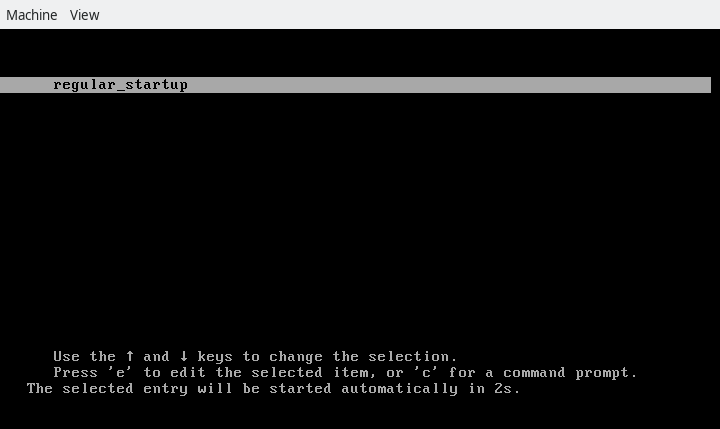 Grub !
Grub !
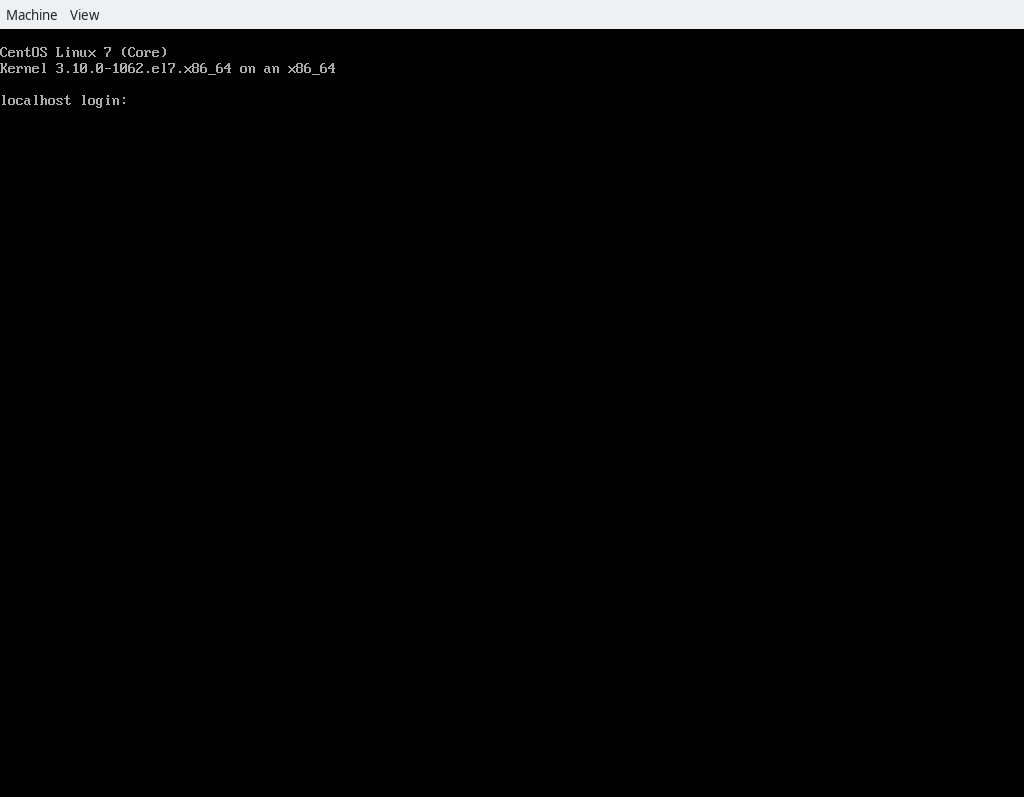 TTY login!
TTY login!
Everything worked great!
You can find the example here.
Booting into the new system without re-booting
To have this behave exactly as I want, I'd also like to remove the intermediate reboot step after flashing.. after all, the same kernel is loaded, why do we need to power cycle?
There are a few gotchas though, after flashing the disk, the kernel does not
know that we have a new partition table, and we can tell it by running
partprobe /dev/sda, which will print the new partition in the kernel logs
(/dev/sda1).
Even though the kernel knows about /dev/sda1, there's no block device
representing it in /dev, so we have to run mdev again, now /dev/sda1
exists!
We try to mount it and..
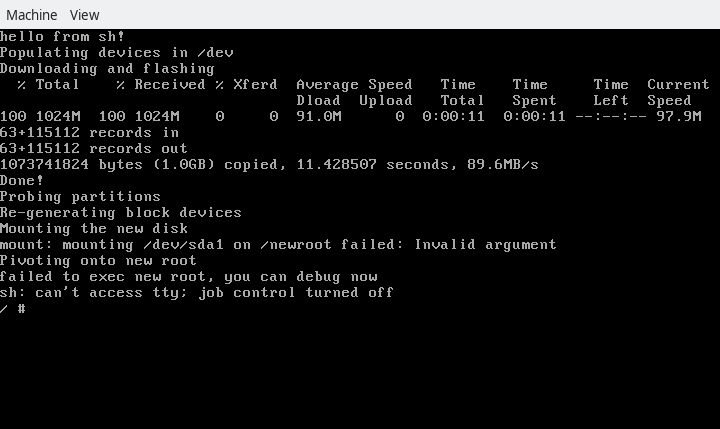
Invalid argument?
Let's try specifying the filesystem:
/ # mount -t xfs /dev/sda1 /newroot/
mount: mounting /dev/sda1 on /newroot/ failed: No such device
Wait.. does this kernel know about xfs? Let's check the configuration options in the original machine that 'donated' this kernel:
$ grep XFS /boot/config-$(uname -r)
CONFIG_XFS_FS=m
Aha! It's a module. Let's add this module as well and try again:
xfs_ko=$(find /lib/modules/$(uname -r) -name xfs.ko)
mkdir -p initramfs/$(dirname $eth_ko) initramfs/$(dirname $xfs_ko)
cp $eth_ko initramfs/$(dirname $eth_ko)
and then we add modprobe xfs to our init, but no dice:
modprobe: module 'libcrc32c' not found
modprobe: 'kernel/fs/xfs/xfs.ko': unknown symbol in module or invalid parameter
this kernel module has dependencies! let's check on the dev machine what they are:
$ lsmod | head -1; lsmod | grep -i xfs
Module Size Used by
xfs 1232896 0
libcrc32c 16384 3 nf_conntrack,nf_nat,xfs
so, we need libcrc32c as well and we'll add it in the exact same way that we
added xfs.
This is it! We are done! We can download and flash a golden disk image over the network, and pivot into it within 20 seconds!
You can find the example here.
Results
You can see the results here (click the image to watch the asciicast):
 RSS feed
RSS feed